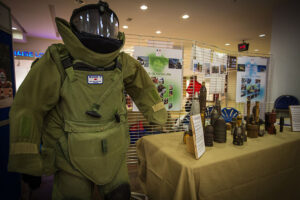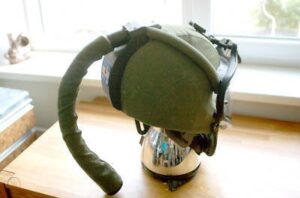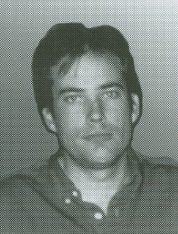I dug this out of the musty recesses of my hard drive; my impressions from 20+ years ago of trying out for the EOD Unit. It reads a little choppy to me now; but meh.
It doesn’t look like much, laying on the ground in front of me. A pair of thick, olive-drab green overalls with curious looking half-booties attached. An oversized helmet with a large crest and a cloth patch embroidered with a maple leaf and the words “MED ENG”. I pick up the lump and it resolves into a large jacket festooned with velcro flaps. It feels like it’s lined with phone books, and weighs around 50 pounds. That’s not too bad, I think. It’s not that heavy.
I step back and look around. It’s a beautiful day, warm for January; even for the deep south. The sun bleached the concrete of the stadium a hard white and picked out every detail of the football turf. I wonder how long this will take- I still have an eye doctor’s appointment this afternoon. I thought back to the day a few weeks ago when the assistant chief called me into his office and asked if I wanted to be on the bomb squad. Hell fuzzy yes, I said. I wasn’t about to turn down a school like the FBI’s Explosive Ordnance Disposal class. There’ll be some tests, he said. A full physical. Eye exams. A psychological. And today.
Today I had to put on the bomb suit, pick up the disrupter and its stand, and carry it 100 yards. I’d set it up, take it down again, and carry it back. I picked up the disrupter. It was a three foot long polished steel tube; basically, a big shotgun barrel. A small charge, like a shotgun shell, was placed in one end. The business end got pointed at the suspect device. It shot a column of water through the bomb, severing wires and destroying control circuits. The water jet could penetrate a steel ammo can, blasting apart anything inside, before it could trigger itself. Hopefully. Attached to its small, custom made stand, it weighed perhaps 40 pounds. 100 yards? Hell, I could carry this 1,000 yards. No sweat. It was unwieldy, but not onerously heavy.

“You ready?” the agent from the Georgia Bureau of Investigation asked me. He was a little shorter than me, with close-cropped hair and clean shaven, angular features. They must order their agents from the same catalog, I thought. GBI Model 23R, Special Agent, Male. They all look alike. But he was pleasant enough, patient and not condescending to obviously untrained, neophyte bomb techs like myself. I nodded. “Sure.”
He held out the overalls and I shrugged into the shoulder straps. I fastened the velcro flap across my chest- I knew enough to do that. The GBI agent slid the half-booties over the toes of my shoes and began zipping the pants legs up. You can’t put on a bomb suit by yourself, unless you’re a masochistic contortionist. It’s put on you, by someone else- you’re just along for the ride.
I bent at the knees. The material of the pants was heavy, maybe a half-inch thick. It was a little confining, but loose. I had more mobility in it than I did with my quarter-inch thick neoprene wet suit. I stuck my arms in the sleeves of the jacket the agent held open for me.
Oof. This was a bit heavier. The jacket wrapped completely around my body. The sleeves were a bit long; but at $15,000 a suit, you can’t afford to pay for a custom fit. The agent busied himself sealing flaps and zipping zippers. A high collar, as yet unfastened, prevented my watching him.
I looked down at my hands. The sleeves extended over the backs of my hands, but they were otherwise unprotected. The only parts a bomb suit doesn’t cover are your hands and butt. You can’t perform delicate operations in thick gloves, and you have no sense of touch. The hands will be the first things to go- not that the rest of you wouldn’t follow soon after. Med Eng says that 9 people have been caught by explosions while in an EOD-7B; and two of them died. Med Eng says they died because they were too close to the explosion.
Well, no shit.
Your butt won’t be facing the explosion unless you’re running away. I fingered the quick-release toggles on my chest. Grab ’em and yank, and the entire suit would fall away so you could run unhindered. I wondered how often that happened.
The helmet was next. For all its size, it was cramped inside. The agent slid the chin cup in place and tightened the strap. He hooked the half-inch thick polycarbonate faceplate into the bottom of the helmet and secured the top with a rubber strap. The helmet was now as quiet as a tomb.
“Can you hear me?” he asked. Surprisingly, I could. A microphone on the helmet transmitted the outside noises to an earpiece inside. A communication wire could be plugged into a jack on the helmet, allowing the operator to talk to others back at the bomb trailer. The wire unreeled from a spool that could be hooked to the side of the suit. No radios here- some devices are sensitive to radio frequencies.
I nodded to him. He hooked a hose into the back of the helmet, and air hissed in. He guided my right hand to a box on my hip.

“OK, this button is the turbo switch. Hit it, and the fan goes on high for ten seconds.” I pressed it, and the hissing grew louder. I could feel the air across my face. “Behind it are the fan control switches. Top one speeds the fan up, bottom one slows it.” He stepped back. “OK, that’s it.”
I bent down to pick up the disrupter. Hmm, this was going to be more difficult than I thought. The suit hampered my movements, and the high collar virtually immobilized the helmet. I had to bend over to look down.
Put on as many pairs of sweat pants as you can find. Layer on several sweaters and top it off with a thick winter coat that has sleeves a few inches too long. Put on a motorcycle helmet and duct-tape it to the collar of the coat so it can’t move. Then put 50 pounds of lead weight in the pockets. You’ll still have more mobility than I did, although you might get as hot. Now pick up a briefcase filled with sand…
It took me a minute to find a good handhold. I couldn’t really cradle the disrupter in my arms; I had to carry it two-handed in front of me. Already, beads of sweat were lining my forehead, I hefted the disrupter and began shuffling across the field.
I was wrong. This was going to be a lot tougher than I’d thought. I wasn’t just carrying the disrupter; I was carrying the whole suit. I wondered how I’d feel if I were doing this for real, on a real call with a real explosive device waiting for me at the end of the walk. The suit was the perfect place for such introspection; it was like being in a sensory deprivation chamber. I felt a small shudder of claustrophobia and a little twinge of panic. I imagined such feelings would be multiplied on a real call.
100 yards. I gratefully set the disrupter down and rested. I unfolded the legs of the base and adjusted the angle of the barrel so it pointed squarely at a bronze statue of the school’s mascot. I leaned back and looked at the GBI agent.
“OK, good.” He said. “Now pick it up, and let’s head back.” I sighed and folded the legs once more.
If anything, the walk back was longer. I started panting about halfway. I hoped the agent couldn’t hear me. I was amazed that the ventilation system kept the visor clear. I could easily see why some folks panic when suited up. Instead of feeling like a safe, albeit heavy, security blanket, the suit felt more like a lead noose. Like those nightmares where you’re running from the monsters, but your feet are encased in clinging mud.
We made it to the end zone and I almost threw the disrupter down. The agent stripped the suit off of me with the efficiency of an expert. I wiped my brow and regarded the suit, now reduced once again to a pile of green cloth. Certainly different from Hollywood’s version of the bomb tech, where a handsome hero agonizes over a couple of wires attached to a fiendishly complex and exotic device before snipping one, seconds before detonation. The reality was that a robot was driven to the device by remote control, and a disrupter was used to render it harmless. The tech goes only if the robot can’t. Snipping wires is a last resort. And the cleverly constructed device? Usually a pipe filled with gunpowder or match heads. Then again, reality is boring- unless you’re the guy in the suit.


